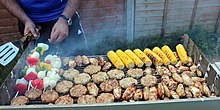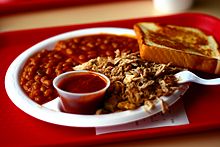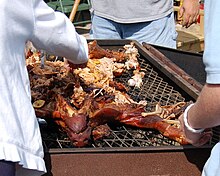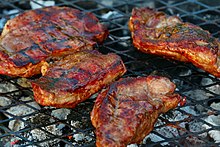Where Does Barbecued Beef Originate From

Charcoal-broil or barbeque (informally BBQ in the UK and US, barbie in Commonwealth of australia and braai in South Africa) is a term used with meaning regional and national variations to describe various cooking methods which utilise live fire and smoke to cook the food.[1] The term is also generally applied to the devices associated with those methods, the broader cuisines that these methods produce, and the meals or gatherings at which this mode of nutrient is cooked and served. The cooking methods associated with barbecuing vary significantly but most involve outdoor cooking.
The diverse regional variations of barbecue can exist broadly categorized into those methods which use direct and those which use indirect heating.[1] Indirect barbecues are associated with Northward American cuisine, in which meat is heated by roasting or smoking over wood or charcoal.[ii] These methods of barbecue involve cooking using smoke at depression temperatures and long cooking times (several hours). Elsewhere, barbecuing more commonly refers to the more direct application of heat, grilling of food over hot coals or gas.[i] This technique is usually washed over direct, dry heat or a hot fire for a few minutes. Within these broader categorizations are further national and regional differences.[2]
Etymology and history [edit]

Barbecued hickory-smoked, babe-back pork ribs

A barrel-shaped smoker on a trailer. Pans on the top shelf hold hamburgers and hot dogs. The lower grill is being used to cook pork ribs and "drunken craven".
The English give-and-take barbecue and its cognates in other languages come up from the Spanish word barbacoa. Etymologists believe this to be derived from barabicu plant in the linguistic communication of the Arawak people of the Caribbean area and the Timucua people of Florida;[3] it has entered some European languages in the class of the same barbacoa. The Oxford English language Dictionary (OED) traces the word to Hispaniola and translates it every bit a "framework of sticks set upon posts".[4]
Gonzalo Fernández De Oviedo y Valdés, a Spanish explorer, was the first to utilise the discussion "barbecoa" in print in Espana in 1526 in the Diccionario de la Lengua Española (2nd Edition) of the Real Academia Española. After Columbus landed in the Americas in 1492, the Spaniards manifestly found Taíno roasting meat over a grill consisting of a wooden framework resting on sticks above a fire. The flames and smoke rose and enveloped the meat, giving it a certain flavour.[v]
Traditional barbacoa involves earthworks a hole in the ground and placing some meat—usually a whole lamb—above a pot then the juices tin can exist used to make a goop. It is and so covered with maguey leaves and coal, and set up debark. The cooking process takes a few hours. Olaudah Equiano, an African abolitionist, described this method of roasting alligators among the Mosquito People (Miskito people) on his journeys to Cabo Gracias a Dios in his narrative The Interesting Narrative of the Life of Olaudah Equiano.[6]
Linguists have suggested the give-and-take was loaned successively into Spanish, and so Portuguese, French, and English. In the form barbacado the word was used in English in 1648 by the supposed Beauchamp Plantagenet in the tract A clarification of the province of New Albion: "the Indians in stead of salt doe barbecado or dry out and smoak fish".[7]
According to the OED, the showtime recorded apply in modern form was in 1661, in Edmund Hickeringill's Jamaica Viewed: "Some are slain, And their flesh forthwith Barbacu'd and eat";[four] information technology likewise appears in 1672 in the writings of John Lederer following his travels in the North American southeast in 1669–1670.[8] The beginning known use as a substantive was in 1697 by the English language buccaneer William Dampier. In his New Voyage Round the Earth, Dampier wrote, "and lay there all nighttime, upon our Borbecu'southward, or frames of Sticks, raised about 3 foot [0.91 m] from the Basis".[9]
As early on equally the 1730s, New England Puritans were familiar with barbecue, as on 4 November 1731, New London, Connecticut, resident Joshua Hempstead wrote in his diary: "I was at Madm Winthrops at an Entertainment, or Care for of Colln [Colonel] or Samll Brownes a Barbaqued."[x] Samuel Johnson'southward 1756 dictionary gave the following definitions:[11]
- "To Barbecue – a term for dressing a whole sus scrofa" (attestation to Pope)
- "Barbecue – a squealer dressed whole"
While the standard modern English spelling of the word is barbecue, variations including barbeque and truncations such as bar-b-q or BBQ may besides be found.[12] The spelling barbeque is given in Merriam-Webster and the Oxford Dictionaries equally a variant.[13] [xiv] In the southeastern United States, the word charcoal-broil is used predominantly as a noun referring to roast pork, while in the southwestern states cuts of beef are ofttimes cooked.[fifteen]
Associations [edit]
Because the word charcoal-broil came from native groups, Europeans gave information technology "fell connotations".[16] : 24 This association with barbarians and "savages" is strengthened by Edmund Hickeringill's piece of work Jamaica Viewed: with All the Ports, Harbours, and their Several Soundings, Towns, and Settlements through its descriptions of cannibalism. However, according to Andrew Warnes, there is very lilliputian proof that Hickeringill's tale of cannibalism in the Caribbean is even remotely true.[xvi] : 32 Some other notable false depiction of cannibalistic barbecues appears in Theodor de Bry's Not bad Voyages, which in Warnes'due south eyes, "present fume cookery as a custom quintessential to an underlying savagery [...] that everywhere contains within it a potential for cannibalistic violence".[16] : 36 Today, those in the U.Southward. associate charcoal-broil with "classic Americana".[xvi] : iii
Styles [edit]

A British barbecue including chicken kebabs, marinated chicken wings, sweetcorn, and an assortment of vegetables
In American English usage in the Southern U.Southward, grilling refers to a fast procedure over loftier heat while barbecuing refers to a slow process using indirect rut or hot fume, similar to some forms of roasting. In a typical U.S. home grill, food is cooked on a grate directly over hot charcoal, while in a U.S. barbecue the dress-down are dispersed to the sides or at a significant distance from the grate. However in the Northern U.S the term barbecuing includes grilling; for instance in northern states charcoal-broil fare ofttimes includes grilled hot dogs and hamburgers (which in the southern states would be considered fare for grilling or a cookout). In British usage, barbequeing refers to a fast cooking process done directly over high heat, while grilling refers to cooking under a source of straight, moderate-to-loftier heat—known in the United States as broiling. Its Southward American versions are the southern Brazilian churrasco and the Argentine asado.[17]
United States [edit]

Typical plate of chopped pork barbecue every bit served in a restaurant with barbecue beans, sauce, and Texas toast

According to estimates, prior to the American Civil War, Southerners ate around five pounds of pork for every pound of beef they consumed.[xviii] Because of the try to capture and cook these wild hogs, squealer slaughtering became a time for celebration and the neighborhood would be invited to share in the largesse. In Louisiana Creole and Cajun civilisation, these feasts are called boucheries or "pig pickin'south". The traditional Southern charcoal-broil grew out of these gatherings.[nineteen]
Each Southern locale has its ain diverseness of charcoal-broil, particularly sauces. S Carolina is the only state that traditionally includes all 4 recognized barbecue sauces, including mustard-based, vinegar-based, and low-cal and heavy tomato-based sauces. North Carolina sauces vary by region; eastern North Carolina uses a vinegar-based sauce, the center of the country uses Lexington-style barbecue, with a combination of ketchup and vinegar as their base, and western Due north Carolina uses a heavier ketchup base. Memphis barbecue is all-time known for tomato- and vinegar-based sauces. In some Memphis establishments and in Kentucky, meat is rubbed with dry out seasoning (dry out rubs) and smoked over hickory forest without sauce. The finished barbecue is then served with barbecue sauce on the side.[twenty]
The barbecue of Alabama, Georgia, and Tennessee is almost ever pork, often served with a sweet tomato-based sauce. Several regional variations exist. Alabama is also known for its distinctive white sauce—a mayonnaise- and vinegar-based sauce originating in northern Alabama, used predominantly on chicken and pork. A pop item in Northward Carolina and Memphis is the pulled pork sandwich served on a bun and oft topped with coleslaw. Pulled pork is prepared by shredding the pork after information technology has been barbecued.[21]
Kansas City-style barbecue is characterized by its use of different types of meat, including pulled pork, pork ribs, burnt ends, smoked sausage, beef brisket, beef ribs, smoked/grilled chicken, smoked turkey, and sometimes fish—a diverseness owing to Kansas City'south history as a center for meat packing. Hickory is the primary wood used for smoking in Kansas Metropolis, while the sauces are typically tomato based with sweet, spicy, and tangy flavors.
Pit beefiness prevails in Maryland and is often enjoyed at large outdoor "bull roasts", which are ordinarily fundraising events for clubs and associations. Maryland-style pit beef is not the product of barbecue cookery in the strictest sense; the meat is not smoked simply grilled over a high oestrus. The meat is typically served rare with a strong horseradish sauce every bit the preferred condiment.[22]
The state of Kentucky, particularly the western region around Owensboro and Henderson, is unusual in its barbecue cooking; the preferred meat is mutton.[23] This kind of mutton barbecue is often used in communal events in Kentucky, such as political rallies, canton fairs, and church fund-raising events.[twenty]
Barbecue in Texas is predominantly beefiness due to the state's historic ties to cattle raising.
South Africa [edit]
Braais are informal gatherings of family and friends who convene around an open fire for whatsoever occasion and at any location with a grill. They are linked to the consistent warm weather condition of Southward Africa that leads to much communal, outdoor action.[24] The act of convening around a grill is reminiscent of past generations gathering effectually open fires after a chase, solidifying the braais' importance to tradition.[25] Modernity has expanding grilling to the utilize of gas grills, only steel grill gates and campfires are frequently used.[25] The utilize of a gas grill is frowned upon and the use of charcoal is accepted, but wood is seen every bit the all-time method to cook the meat.[26]
It is expected that people attending a braai bring snacks, drinks, and other meat to swallow until the main repast has finished cooking on the grill. This potluck-similar activity is known as "bring and braai".[27] Cooking on the braai is a bonding experience for fathers and sons, while women prepare salads and other side dishes in kitchens or other areas away from the grill.[28] Examples of meat prepared for a braai are lamb, steaks, spare ribs, sausages, chicken, and fish.[24] Milie pap, besides known equally "Krummel Pap", is a crumbled cornmeal that is often served as a side dish.[29] [24]
Heritage Twenty-four hour period in South Africa, celebrated on 24 September, has too come to be known equally National Braai Day, changed to Braai4Heritage, since the holiday is usually celebrated with one.[27] Desmond Tutu advocated for National Braai Solar day in 2007 due to the universal enjoyment of braais across races in Due south Africa, stamping information technology as a symbol of South African heritage.[29]
Techniques [edit]

Diagram of a propane smoker used for barbecuing
Barbecuing encompasses multiple types of cooking techniques. The original technique is cooking using smoke at low temperatures—ordinarily around 116–138 °C (240–280 °F)—and significantly longer cooking times (several hours), known as smoking.[ commendation needed ]

A public barbecue site at a park in Oulu, Finland, on 23 March 2014
Grilling is done over directly, dry heat, usually over a hot fire over 260 °C (500 °F) for a few minutes. Grilling may be done over forest, charcoal, gas, or electricity. The time divergence between smoking and grilling is because of the temperature difference; at low temperatures used for smoking, meat takes several hours to reach the desired internal temperature.[xxx] [31]
Smoking [edit]
Smoking is the process of flavoring, cooking, and/or preserving nutrient by exposing it to smoke from called-for or smoldering textile, most often wood. Meat and fish are the most common smoked foods, though cheeses, vegetables, nuts, and ingredients used to make beverages such equally beer or smoked beer are also smoked.[32] [33]
Grilling [edit]

Lamb grilling over hot dress-down
Grilling is a class of cooking that involves a dry out estrus applied to the food, either from above or below. Grilling is an effective technique in order to melt meat or vegetables apace since it involves a meaning amount of straight, radiant oestrus. In that location are many methods of grilling, which involve a type of braising or roasting. This is 1 of the least common techniques when cooking classic barbecue foods.[34]
The words "charcoal-broil" and "grilling" are often used interchangeably, although food experts debate that barbecue is a type of grilling, and that grilling involves the use of a college level of estrus to sear the nutrient, while barbecuing is a slower process over a low heat.[35]
Other uses [edit]
The term barbecue is besides used to designate a flavor added to food items, the near prominent of which are potato chips.[36]
See also [edit]
- Asado – Meat dish traditional in Uruguay, Argentina, Paraguay and Republic of chile
- Barrel barbecue – Type of barbecue made from a 55-gallon butt.
- Braai
- Burnt ends – Barbecued meat delicacy
- Carne asada – Dish of grilled and sliced beef
- Char siu – Cantonese mode of barbecued pork
- Churrasco
- Kansas Urban center-style barbecue – Dish of slowly smoked meat originating in Kansas
- Kebab – Diversity of meat dishes originating in the Heart East
- Korean charcoal-broil – Style of food preparation in Korean cuisine
- List of barbecue dishes
- List of barbecue restaurants
- Listing of smoked foods
- Mangal – Center Eastern barbecue
- Memphis-style barbecue – Regional style of barbecue in the United States
- Mongolian charcoal-broil – Stir-fried dish
- Northward Carolina barbecue
- Regional variations of barbecue – Meat
- Ribfest – Type of nutrient festival that occurs throughout the The states and Canada
- Satay – Indonesian dish of spicy seasoned, skewered and grilled meat, served with a sauce
- Shaokao, Chinese charcoal-broil
- Shashlik – Grade of shish kebab
- Spice rub
- St. Louis-manner barbecue – Spare ribs dish
- Teppanyaki – Style of Japanese cuisine
- Texas Barbecue – Barbecue unique to Texan cuisine
- Yakiniku – Style of Japanese food preparation
References [edit]
- ^ a b c Bawdon, Michael. "A guide to unlike types of barbecue". Corking British Chefs. Retrieved 8 April 2021.
- ^ a b Moss, RF (2020). Barbecue: the history of an American institution. Academy Alabama Printing.
- ^ Hale, C. Clark (2000). The Nifty American Charcoal-broil and Grilling Manual. McComb, MS: Abacus Pub. Co. ISBN0936171022. [ page needed ]
- ^ a b "Oxford Lexicon". Former.cbbqa.org. Archived from the original on 21 Apr 2021. Retrieved 12 December 2015.
- ^ Peters, Philip Dickenson (2003). Caribbean Wow 2.0 (1st ed.). Coral Gables, Fla.: House of Zagada. p. 27. ISBN9781929970049 . Retrieved 12 December 2015.
- ^ Equino, Olaudah (2012). The Interesting Narrative of the Life of Olaudah Equiano. Lanham: First Publishing LLC. p. 316. ISBN978-1625584717 . Retrieved 12 Dec 2015.
- ^ Plantagenet, Beauchamp (1648). "4". A clarification of the province of New Albion . Retrieved 15 March 2019.
- ^ Lederer, John (1672). The Discoveries of John Lederer. p. 28. Retrieved 12 December 2015.
- ^ Dampier, William. A New Voyage Round the World. Ripol Classic. p. 20. ISBN1148385150 . Retrieved 12 December 2015.
- ^ Hempstead, Joshua (1901). Diary of Joshua Hempstead of New London, Connecticut. New London County Historical Society. p. 241. ISBN9780259727545.
- ^ Johnson, Samuel (1756). A dictionary of the English language language. Oxford University. p. 70. Retrieved 12 Dec 2015.
- ^ "storySouth / southern barbecue BBQ civilisation and foodways". Storysouth.com. 5 April 2002. Retrieved 6 September 2012.
- ^ "Barbeque". Costless Merriam-Webster Dictionary. Retrieved 6 September 2012.
- ^ "Definition of charcoal-broil". Oxford Dictionaries (British & Earth English). 24 June 2013. Retrieved 24 June 2013.
- ^ "America searches for the perfect barbecue". Newsweek. 103 (nineteen–26). May 1984. Retrieved 12 December 2015. [ page needed ]
- ^ a b c d Warnes, Andrew (2008). Savage Barbecue: Race, Culture, and the Invention of America's First Food. University of Georgia Press. ISBN9780820328966.
- ^ Matthew Bell (18 July 2013). "Gaucho grill: How to cook the Argentinian manner | Reviews | Lifestyle". The Independent . Retrieved 12 December 2015.
- ^ Taylor, Joe Gray (1982). Eating, Drinking, and Visiting in the Southward: An Informal History (Louisiana pbk ed.). Baton Rouge: Louisiana State Univ. Printing. p. 27. ISBN0-8071-1013-two . Retrieved 12 Dec 2015.
- ^ Geiling, Natasha. "The Evolution of American Barbecue". Smithsonian . Retrieved 7 May 2018.
- ^ a b "A Year of Barbecue: Kentucky Mutton - Food Republic". Food Republic. 13 March 2012. Retrieved 7 May 2018.
- ^ "What's the secret to making tender, juicy pulled pork?". Food . Retrieved vii May 2018.
- ^ Raichlen, Steven (28 June 2000). "How to Say Barbecue in Baltimore". New York Times. Baltimore (Md). Retrieved 12 December 2015.
- ^ "Stalking the Barbecued Mutton". The New Yorker. seven February 1977. Retrieved 12 Dec 2015.
- ^ a b c Savides, Steven (12 June 2002). "The braai unites Due south Africans". Christian Science Monitor. 94: 16.
- ^ a b Moskin, Julia (23 May 2016). "South Africa, One Nation United by the Grill". The New York Times. ISSN 0362-4331. Retrieved 6 Apr 2021.
- ^ "Things Y'all Must Know About South African Braai -". The Travels of BBQboy and Spanky. 26 August 2019. Retrieved 6 Apr 2021.
- ^ a b Isabella., Morris (2017). South Africa - Civilisation Smart! : the Essential Guide to Customs & Civilisation. Kuperard. ISBN978-1-78702-966-8. OCLC 1001989214.
- ^ Matloff, Judith (16 January 1997). "Due south. African Braai: It'due south a Guy Thing". Christian Science Monitor. 89.
- ^ a b Nugent, Paul (December 2010). "Do Nations Have Stomachs? Food, Beverage and Imagined Community in Africa". Africa Spectrum. 45 (iii): 87–113. doi:10.1177/000203971004500305. ISSN 0002-0397. S2CID 73719750.
- ^ McElhiney, Jacqui (24 July 2015). "How to cook meat properly on the barbecue". BBC Skilful Food. Retrieved 14 April 2016.
- ^ "Barbecue 101". SAVEUR. 17 June 2011. Retrieved fourteen April 2016.
- ^ Colby, Chris. "Smoked Beer". Retrieved nineteen October 2017.
- ^ McGee p. 767: "Malt whiskies from Scotland's w coast have a unique, smoky flavor that comes from the use of peat fire for drying the malt."
- ^ "Grill vs barbecue – do you know the difference?". Global News . Retrieved 7 May 2018.
- ^ Grinberg, Emanuella (6 July 2015). "The difference between grilling and charcoal-broil". CNN . Retrieved 16 May 2018.
- ^ Hayes, Dayle; Laudan, Rachel (2009). Food and Nutrition/Editorial Directorate, Dayle Hayes, Rachel Laudan. Marshall Cavendish. ISBN9780761478201.
External links [edit]
| | Await up barbecue in Wiktionary, the free dictionary. |
- . Encyclopædia Britannica. Vol. iii (11th ed.). 1911.
- Charcoal-broil Nutrient Safety (U.S. Dept. of Agriculture)
- The Cyberspace BBQ FAQ Archived 27 April 2021 at the Wayback Car
- Barbecue: A History of the World's Oldest Culinary Fine art Web bandage from the Library of Congress
parkerplaragnight45.blogspot.com
Source: https://en.wikipedia.org/wiki/Barbecue
0 Response to "Where Does Barbecued Beef Originate From"
Post a Comment